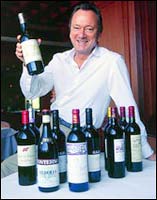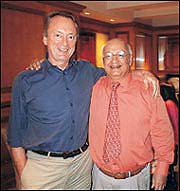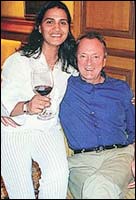


 The Wine Merchant Of London
The Wine Merchant Of LondonASIT CHANDMAL profiles his friend JOHN ARMIT, a bon viveur and wine merchant extraordinaire, who gave Bombay its finest food and wine dinner in ages recently. |
|
IT is given to very few people to live a life where they follow their passions single-mindedly, and make considerable commercial gains while enjoying themselves immensely. And in the process also win the unstinting praise of their peers. Sachin Tendulkar comes immediately to mind. John Armit, in a completely different context, is another such person.
Chateau Petrus in Pomerol, Bordeaux, annually produces small quantities of the most sought after red wine in the world. And yet they chose to give the exclusive rights for its sale in the lucrative UK market to Armit, as far back as 1978. Why? The answer typifies Armit's unorthodox way of working and living. In the late 1960s the wines of Pomerol were virtually unknown. They were used mainly to blend with other, more famous, Bordeaux wines. Armit, who was then working for the City of London�s Corney and Barrow, did something unheard of in the UK or the USA wine trade. Instead of buying through local brokers, he started actually visiting vineyards in France, tasting on the spot, discussing the wines, the terroir, and the viniculture methods with the wine-maker. Above all, Armit trusted his palate totally. He was astounded by the quality of these wines. He started buying wines from Petrus�s sister property, Chateau Lafleur-Petrus, which is adjacent to Petrus and under the same management, in large quantities at absurdly low prices. Soon afterwards he bought thousands of cases of Chateau Petrus at similarly low prices. Remember this was 35 years ago. When, by the early 1980s, these wines had become world famous, Armit was sitting on a gold mine.
Christian Mouiex, owner and winemaker of Chateau Petrus, says, "John Armit is one of the four finest tasters I know." And he should know, his vineyard being the wine world�s Mecca. Italy�s most sought after wine is the super Tuscan �Sassicaia�. Its owner, Nicolo Incisa Della Rochetta, says, "John has the greatest of palates and is without doubt one of the most brilliant wine merchants in Europe." The most famous winemaker in Italy, the legendary Angelo Gaja, avers, "John Armit was the first Englishman to understand the quality of the wines of Piedmont. It is thanks to him that our wines are so well known and liked in Britain." As a result, Gaja gave Armit the exclusive rights for his to-die-for single vineyard Barolos and Barberescos, and so did other great wine makers such as Giacomo Conterno, and even Nicolo Incisa for �Sassicaia�.
There is similar praise of the highest order, inter alia, from Anne Claude Leflaive, the owner of Domaine Leflaive, the maker of the most exquisite white Burgundies, and from Chateau Margaux. But it was the judgement of the most influential wine critic in the world, Robert Parker, who said of Armit: "He has one of the best palates in the world" that made Forbes magazine choose John Armit to make up its case of wine for the Millennium, for sale to its highly successful readers. Quoting Robert Parker and Christian Moueix, they wrote, "When Forbes decided to offer the best and most difficult to obtain French and Italian wines, our prime concern was to provide our readers with the highest quality wines at the most reasonable prices. We have chosen to work with John Armit, one of the most highly respected international wine merchants today. With a network of contacts in Bordeaux, Burgundy, and Italy that is second to none, Armit has been exclusively engaged by Forbes." Forbes could have chosen any wine merchant in the world, but they chose John Armit, quite rightly. The cases were sold out. As a result Armit�s fame soared globally, even outside the wine world.
John Armit was educated at the same school and university as Tony Blair, Fettes and Oxford, and also at the Sorbonne. It was while he was living as a student in Paris that Armit�s step father initiated him, quite literally, into the world of wine, women and song, and restaurants with great food. These passions have not abated but grown with time. Aside from his extraordinary career in the wine trade, Armit has founded several of the most sought after clubs in London: Dingwalls, Zanzibar, 192, Bush Bar and Grill, and the Groucho. The earliest clubs were the direct result of visiting Andy Warhol�s legendary Max�s Kansas City in 1969 in New York. The Velvet Underground were playing. At the time London had only pubs, hotel bars, and fuddy duddy exclusively men�s only drinking places (clubs), all quintessentially British. John Armit looked at Max�s Kansas City, and thought, "Why not? After all it is supposed to be swinging London." The rest, as they say, is history.
The Garrick is a venerable and venerated literary club in London. Only men were allowed to become members. It wasn�t a fun place. It did not seem to have young people. Seeing a great opportunity, Armit and Tony Mackintosh started a rival, �Groucho� (after Groucho Marx�s "I refuse to be a member of a club which will admit me as a member"). Groucho was and is an enormously successful club in Soho. And so on.
Armit lives in a lovely house in famed Portobello Road in the heart of London�s trendy Notting Hill, from where he walks to his offices in nearby Ladbroke Grove. He also commutes regularly to his house in the South of France. What now? The slim, debonair 62-year-old Armit (who swims regularly, looks 50, and from certain angles resembles Clint Eastwood) wants good wine to be available to everyone, to be enjoyed without any pretentious ritual. He has persuaded some of the world�s top wine makers (Michael Seresin in New Zealand, Steenberg in South Africa, Christian Mouiex and the Lurton Brothers in Bordeaux) to create wines which are sold under the simple and colourful label �John Armit Wines�, and which are now widely available at Selfridges etc. To me they represent the best and the most reliable value-for-money wines being sold at reasonable prices in England.
Recently John told me he was planning a trip to India, to visit one of his daughters who is spending her gap year, between school and university, teaching English in a village in Tamil Nadu. He said, "I�ll bring along a few wines. Why don�t you invite some of your friends, not more than say 6 or 7, and we will drink these wines in an informal setting, ideally in your home." I agreed. But when John e-mailed me the list of wines he was bringing with him, I was flabbergasted. They were absolutely top quality Bordeaux wines. So began the search for an appropriate dining venue, with accomplished chefs who would do my bidding, a staff who would not only serve the great wines, but also serve them immaculately. (John himself would decant them; over a most enjoyable lunch at the Kandahar I had gone over the mechanics and logistics of the dinner with him.) I settled on the Rotisserie at the Oberoi, thanks to Sanjiv Malhotra, the senior vice-president, Oberoi, who responded most helpfully, chefs Joy Bhattacharya and Christian Rose, and sommelier Bhargava. We had several meetings and tastings. My friend Sanjay Menon of Sansula agreed to provide the Riedel decanters and the appropriate Riedel glasses (72 of them, eight each for the nine diners), a most generous offer which, in the event, considerably enhanced the aroma and flavour of what were truly amazing wines. (See accompanying menu). The evening, with the men dressed in suits out of respect for the wines, was an unalloyed success. The Oberoi surpassed itself. Some of the guests said that they had not eaten such a magnificent western dinner at the Oberoi, or anywhere else in India.
After organising the dinner, I left on a week�s wine and food trip to Italy. Word of the proposed dinner had spread. It was inevitable. Rahul and Malini Akerkar of Indigo wanted John Armit to be the chief guest at a sit down dinner for 45 people, to celebrate their Wine Spectator Award for Excellence. The food was to be personally and innovatively cooked by Rahul Akerkar, and the wines to be supplied by Sanjay Menon, to be served in his indispensable Riedel glasses.
The Taj graciously suggested lunch at the Zodiac, and I agreed. I selected very good Italian wines. I offered to bring back from my trip Porcini mushrooms, white truffles, Parma ham and Parmesan cheese, and Balsamic vinegar aged 25 years, all bought at the places where they were made or grown. This was agreed to, as well as the detailed menu I had worked out to match the wines. (See the Zodiac menu alongside)
In the event all three meals achieved what they set out to do: a magnificent Bordeaux Fine Wine dinner at the Oberoi, serious and solemn, with only wine talk, interspersed with sips of legendary wines; and the next day, a fabulous but utterly relaxed Italian fine wine lunch at the Zodiac, full of laughter; followed by dinner at Indigo, a most amazing achievement by the Akerkars and Menon, stunningly innovative dishes created for a sit down dinner for as many as 45 fun-loving guests, with appropriate wines, served under an open sky. John Armit left early the next morning for Trivandrum where his daughter was meeting him. When I asked him, after all the meals, his preference in wines, Bordeaux or Piedmont, he quoted his good friend Angelo Gaja, "A Cabernet Sauvignon (Bordeaux) is like John Wayne. It is big and strong, and is expected to perform, and does so regularly. But a Nebbiolo (Piedmont) is like Marcello Mastrioanni. You never know what will happen, but you can be sure it will be very exciting."
On that note I said goodbye, for the time being, to John, a man who unswervingly �follows his bliss�. He has initiated, with the finest wine dinner Bombay has seen in ages, an example for us to emulate, which we plan to do with an ongoing series of fine
wine dinners.
|

Home Page
About the mag
Subscribe
Advertise
Contact Us
 He had already become managing director of Corney and Barrow. Conversing with his friend Evelyn Hambro at Samuel Montagu, he arranged to buy out the firm ("on a handshake, no cash flows were discussed"). Thus was John Armit Wines born in 1981. The massive escalation of Pomerol prices that followed led Armit to start a �Fine Wine Investment� business for high net worth individuals. The resulting capital appreciation was phenomenal, much better than alternative investments such as in the stock market. And since the law in the UK considers wine a �diminishing asset�, there is no capital gains tax! Besides, when you buy the wine en primeur and keep it in Armit�s bonded warehouse, where the storage conditions are as close to perfection as you can get, you don�t tie up your capital in import duties or VAT. And unlike the thousands of stocks and bonds investment analysts who propound their �Buy�, �Sell�, �Hold� recommendations daily in the media, very few possess the passion and palate, and the business acumen that Armit has, so
barriers to entry in this business are considerable.
He had already become managing director of Corney and Barrow. Conversing with his friend Evelyn Hambro at Samuel Montagu, he arranged to buy out the firm ("on a handshake, no cash flows were discussed"). Thus was John Armit Wines born in 1981. The massive escalation of Pomerol prices that followed led Armit to start a �Fine Wine Investment� business for high net worth individuals. The resulting capital appreciation was phenomenal, much better than alternative investments such as in the stock market. And since the law in the UK considers wine a �diminishing asset�, there is no capital gains tax! Besides, when you buy the wine en primeur and keep it in Armit�s bonded warehouse, where the storage conditions are as close to perfection as you can get, you don�t tie up your capital in import duties or VAT. And unlike the thousands of stocks and bonds investment analysts who propound their �Buy�, �Sell�, �Hold� recommendations daily in the media, very few possess the passion and palate, and the business acumen that Armit has, so
barriers to entry in this business are considerable.
 Let me end on a personal note. I have been buying truly excellent and also some very great wines from John Armit for the past seven years, and storing them either in his company�s cellars, or in my daughters� apartments in London and Cambridge. I drink these wines when I am in England. They have appreciated greatly in value. I couldn�t afford to buy the same wines now.
Let me end on a personal note. I have been buying truly excellent and also some very great wines from John Armit for the past seven years, and storing them either in his company�s cellars, or in my daughters� apartments in London and Cambridge. I drink these wines when I am in England. They have appreciated greatly in value. I couldn�t afford to buy the same wines now.
 The most difficult part was choosing the invitees, people who had to be genuine wine lovers. Believe me, there are less than a handful in Bombay. Aside from John Armit, Farzana Contractor, and myself, there were only six invitees to each meal, (one of the guests flew down from Delhi to make up the numbers). There were no spouses at the Bordeaux dinner, since I don�t know a single couple where both are deeply appreciative of and know great wine and food, and for whom good wine is by far their preferred drink.
The most difficult part was choosing the invitees, people who had to be genuine wine lovers. Believe me, there are less than a handful in Bombay. Aside from John Armit, Farzana Contractor, and myself, there were only six invitees to each meal, (one of the guests flew down from Delhi to make up the numbers). There were no spouses at the Bordeaux dinner, since I don�t know a single couple where both are deeply appreciative of and know great wine and food, and for whom good wine is by far their preferred drink.